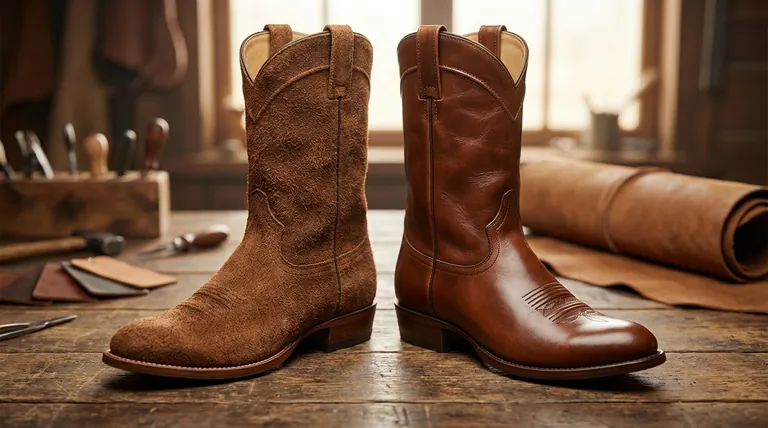The fundamental difference between rough-out and smooth leather in cowboy boots is which side of the animal hide faces outward. Rough-out leather exposes the tough, fibrous flesh side for maximum durability, while traditional smooth leather presents the polished grain side for a classic, refined look. They are, quite literally, two sides of the same coin.
The choice is not about which leather is "better," but which is better suited for your purpose. Rough-out offers superior resilience for hard use and abrasive environments, while smooth leather provides a timeless aesthetic that can be polished for a sharper appearance.

The Core Difference: It's All in the Hide
To understand the distinction, you must first understand the material. A full-thickness piece of cowhide has two distinct sides.
What is Smooth Leather?
This is the traditional and most common finish for cowboy boots. The "grain" side, which is the hide's original outer surface where the hair grew, faces outward.
This surface is naturally smoother and is sanded and polished during the tanning process. This creates the classic, sleek appearance associated with most boots.
What is Rough-Out Leather?
Rough-out leather is the exact same piece of hide, simply flipped over. The "flesh" side, which is the fibrous underside of the hide, now faces outward.
This side is naturally more durable and resistant to scrapes, gouges, and scuffs. It has a napped, textured appearance that is rugged from the start.
A Critical Distinction: Rough-Out is Not Suede
Many people confuse rough-out with suede, but they are fundamentally different.
Rough-out uses the full-thickness, un-split hide, giving it immense strength and durability. It is one of the toughest materials for a boot.
Suede is created by splitting the hide and sanding down the inner layer. This process makes suede much thinner, softer, and significantly less durable than full-grain rough-out.
Function vs. Form: Choosing for Your Purpose
The orientation of the hide directly impacts how the boot performs and looks over time.
The Case for Rough-Out: Unmatched Durability
Rough-out is the definitive choice for a work or riding boot. Its fibrous texture naturally resists and hides the effects of abrasion.
Scratches and scuffs that would permanently scar a smooth leather boot often blend seamlessly into the napped texture of rough-out. It is a true workhorse material designed for demanding conditions.
The Appeal of Smooth Leather: Timeless Versatility
Smooth leather offers the quintessential cowboy boot aesthetic. It can be conditioned and polished to a high shine, making it suitable for a wide range of settings, from casual wear to more formal occasions.
Its versatility and classic look have made it the standard for decades.
Understanding the Trade-offs
Neither option is perfect; the right choice depends on accepting the inherent compromises of each material.
Rough-Out: The Rugged Compromise
The primary trade-off for rough-out's durability is its appearance. It is inherently casual and rugged and cannot be polished for a formal event.
Its textured surface can also hold onto dirt and mud more readily than a smooth finish, requiring regular brushing to stay clean.
Smooth Leather: The Polished Vulnerability
A smooth, polished surface is simply more susceptible to visible damage. A deep scratch or gouge on a smooth leather boot is immediately apparent and can be difficult to repair perfectly.
While durable, it requires more care to maintain its pristine appearance compared to rough-out, which is designed to show wear.
How to Make the Right Choice
Your intended use for the boot should be the primary factor in your decision.
- If your primary focus is work, riding, or high-abrasion activities: Choose rough-out for its superior durability and ability to hide wear and tear.
- If your primary focus is style and versatility for daily wear: Opt for smooth leather, which provides a classic look that can be dressed up or down.
- If you want a low-maintenance boot that ages with rugged character: Rough-out is an excellent choice, as scuffs and scrapes often enhance its intended aesthetic.
Ultimately, understanding this simple difference in construction empowers you to select a boot that will perfectly serve its purpose.
Summary Table:
| Feature | Rough-Out Leather | Smooth Leather |
|---|---|---|
| Outer Surface | Flesh side (fibrous underside) | Grain side (polished outer surface) |
| Primary Advantage | Maximum durability, hides scuffs | Classic, versatile aesthetic |
| Best For | Work, riding, rugged environments | Daily wear, casual to dressy occasions |
| Maintenance | Brushing to remove dirt; scuffs blend in | Conditioning and polishing to maintain shine |
Ready to equip your customers with the perfect cowboy boots?
As a large-scale manufacturer, 3515 produces a comprehensive range of footwear for distributors, brand owners, and bulk clients. Our production capabilities encompass all types of shoes and boots, including both durable rough-out and classic smooth leather options. We can help you source the right boots to meet your market's specific demands for durability, style, and value.
Contact our team today to discuss your production needs and get a quote.
Visual Guide

Related Products
- Durable Rubber Sole Outdoor Shoes Wholesale & Custom Manufacturing
- Durable High-Traction Canvas Sneakers Wholesale & Custom Manufacturing
- Wholesale High-Traction Camo Boots - Custom Manufacturer for Brands
- Wholesale Durable Mid-Cut Tactical Boots for Custom & Private Label Brands
- Durable Mid-Cut Tactical Boots for Wholesale & Private Label
People Also Ask
- What are the characteristics of heavy-duty hiking boots? Ultimate Guide for Rugged Terrain
- What were traditional shoe soles made from before rubber? The History of Leather Soles
- Why are vulcanized soles popular in urban fashion? Discover the Legacy of Authentic Street Style
- What should be considered when choosing hiking boots for snake protection? Prioritize Fit & Materials for Safety
- What are the disadvantages of vulcanized soles? Lack of Support & Durability Explained



















